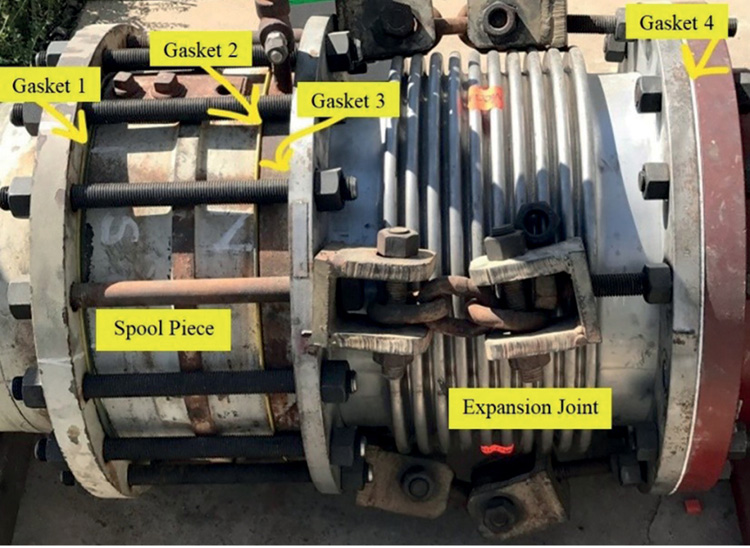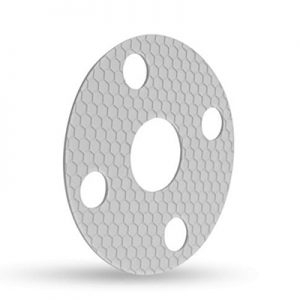How the raised surface profile of PTFE sheet gasket helped a midstream oil and gas processor address leaky pipes
Bolted flange-gasket connections in process piping systems are common and given little thought – unless they start to leak.
Chronic leakage proved to be an issue for one of Garlock's clients, a midstream oil and gas processor and services provider. The site processes, stores, and transports natural gas, liquefied natural gas and petroleum products. Garlock was brought in to provide a solution to the problem.
Successful connections are dependent on a variety of things, including the state of the flange surfaces, alignment, bolt and nut grade and strength, bolt and nut thread condition, lubrication, bolt tightening process, service conditions, and choice of gasket.
When a flange-gasket joint is assembled, the gasket must first be compressed to fill the gaps between the flange surfaces, creating a seal when system pressure is applied. Secondly, it must maintain that seal as the system is brought on-line and temperature and pressure escalate.
As the temperature increases, a gasket made of non-metallic materials such as rubber, fibre, PTFE and inorganic fillers is prone to lose thickness, that is, creep. And the thicker the gasket is, the
more it is prone to creep (1/8-inch thick gaskets creep more than 1/16-inch).
The two most important performance qualities of a gasket are its ability to seal and its ability maintain that seal. These can be indicated by industry standard tests for sealability and creep.
On the surface, this particular case study would seem to be an application of little complexity. However, the details of the joint gave rise to several issues that caused the user chronic leakage problems. Here are the service conditions and background of this particular case:
- Temperature: 100°F to 120°F (38°C to 49°C)
- Flanges and use: 18-inch Class 150 raised face flanges used in the pipe systems of cooling tower water pumps. Multiple gaskets are on either side of spool piece
- Media: Water
- Pressure: 100 psig to 150 psig (7 bar-g to 10.3 bar-g)
The service conditions and media are not extreme. So what caused chronic leakage?
A non-asbestos compressed fibre gasket was being used to seal the flange-gasket joints (Figure 1).

The difficulty of this application does not lie with the service conditions but with flange-joining arrangement. Gaskets 1, 2 and 3 are all compressed and the load maintained by a single set of bolts around the spool piece. Gasket 4 is used in a more traditional arrangement of one gasket being compressed by one set of bolts. The challenge is in understanding gasket creep. As the gasket creeps, it gets thinner and the bolts relax. This causes the bolt force holding the two flanges on either side of the gasket together to diminish, which promotes leakage.
Gasket 4 would experience the creep of one gasket, and then the bolt stretch and load would be diminished accordingly.
Looking at the spool piece where three gaskets are being loaded by one set of bolts, the potential for leaks is increased since there will be three times the amount of bolt stretch/bolt load reduction
due to three times the gasket creep.
The remedy for this issue is to utilize a gasket with low creep properties and high compressibility to conform to flange surfaces while paying close attention to installation procedures.

GYLON EPIX 3510 comes in one thickness: 3/32-inch. The raised surface profile gives it the capability to compensate for poor flange surfaces and begin to seal at lower bolt loads than harder gaskets like compressed non-asbestos fibre sheet. Because it compresses more efficiently and into a thinner thickness, it creeps less than traditional PTFE gaskets. These attributes, coupled with advice on the use of torque wrenches and bolt torque level to attain a seal, maintain that seal, and stretch the bolts the optimum amount to minimize bolt load loss, made for a leak-tight joint.
GYLON EPIX 3510 was installed in October 2018 and continues to seal well to this day.
The original article was featured on Fluid Handling Magazine's website and can be found here. It was written by Jim Drago, Principal Applications Engineer at Garlock
For more information about Garlock's expansion joints or to find out which one might be the right fit for your application, please contact the Gallagher Fluid Seals engineering team.
